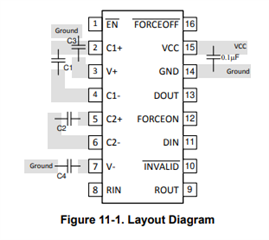Hi team.
My customer is designing the layout for MAX3221.
I guess they have to care about below:
- Parallel and equal length wiring for the Dout Rin.
- For DIN and Rout, creepage distance should be secured atleast twice the line width, and equal length routing is not preferred
- Line width is not specified.
Is there any other tips for the layout guideline to reduce niose?
It will help if there are some collaterals that explains some tips for the layout for this device.
Regards,
Ohashi



